Internet Audio Experiments
“We have also sound-houses, where we practice and demonstrate all sounds, and their generation…. We have also means to convey sounds in trunks and pipes, in strange lines and distances”. [- Quote: Francis Bacon, in his essay “New Atlantis” (1627)]
In the previous blog I discussed the concept behind a new virtual-world audio installation I wanted to create titled 'whisperBox (a 21st century folk song)'.
It occurs to me that it makes sense to introduce this installation by firstly covering some of my earlier research (prior to work in Second Life) that led me this point.
whisperBox is built for use within Second Life, however I really see this installation as the next logical step from my internet-audio experiments that began back in 2001 when I first started tinkering with 'SoundToys', the audio capabilities of Macromedia's Flash and with SDK's for online 3D game environments. This latest installation now complete, I'll use this blog to briefly show some images of the earlier research and then use the next blog to show images of the latest project 'whisperBox' in action within Second Life.
By way of an introduction to this work, here are some short excepts from an article I wrote back in 2001. The article was first published on the front cover of New Notes, a monthly journal by the SPNM (Society for the Promotion of New Music). Five years on, I find it interesting that now a lot of these earlier observations have now become realities:
(If you are interested only in the latest project, skip to next blog).
Internet Audio Experiments. (Extracts)
Thomas Edison was developing a device that could record, then replay at high speed, telegraph signals when he made the first recording of the human voice (Phonograph, 1877). Elisha Gray, who came a close second to Alexander Graham Bell for the title of inventor of the telephone, instead is known as the inventor of the first of the early electronic musical instruments (Musical Telegraph, 1875). Thaddeus Cahill built the precursor to the synthesizer (Telharmonium, 1906), a remarkable machine capable of not only generating but also broadcasting music to public and private residences using telephone technology.
Despite these close beginnings surrounding the technologies of music and those of telecommunication, the World Wide Web remains largely a quiet ‘place’, often more akin to a public library than an integrated multimedia experience. This is not to say that the Internet is mute, far from it, but the relatively slow speed of data transfer typically encountered has precluded the use of audio files from many websites which would otherwise greatly benefit from musical support.
This said, as technology continues to progress, and there is certainly a desire within the Music Industry to utilize the Internet as a means of music delivery (along with other forms of entertainment), we should expect changes and technological advances to cope with the current obstacles. We have already seen some impressive steps forward, for example the introduction of MP3 (a low-loss audio compression which greatly reduces the size of an audio file whilst maintaining high fidelity). In 1997 MP3.com was founded and offered approximately 3000 compressed songs available for free download. In 1998 it became the leading music site on the Internet and received over three million visitors per month, this of course did not pass unnoticed by the commercial eyes of the Music Industry.
More recently we have witnessed the merging of already giant companies from each end of the Music / Internet Service spectrum... ...We have seen the introduction of new legislation concerning the copyright of digital media and ‘Webcasting’ of music. We are also beginning to see a wide-scale take up of ‘Broadband Internet’ by home users. ‘Broadband’ promises much improved transmission speeds and almost certainly brings us one step closer to interactive television and music broadcasting via the Internet.
In the year 2000, the CA*net3 fiber optic network in Canada became the fastest computer network in the world capable of transmitting all nine symphonies of Beethoven in 0.065 seconds.
I find the idea of sharing new musical works, installations, experiments and instruments which have been specially devised for fast Internet delivery very interesting, yet one that has not really been widely taken up. Interesting, in that here is a medium without commercial obstacles, one that easily allows material which may appeal only to a local minority, to find a larger global audience.
I suppose that it is partly because of this freedom, because of the inherent challenge of creating new works for a new medium which are efficient yet interesting (greater than the sum of the parts), and partly because if the ‘Web’ is to become a more interesting ‘place’, music technologists and composers should perhaps begin to claim a much larger stake. For all of these reasons and for personal development, I have decided to begin tentative research into the current possibilities, and limitations of transmitting a variety of music related applications across computer networks.
The following projects are more or less in chronological order:
First up (and isn't it always the way, still one of my personal favorites) is..
WCM: Wind Chime Marimba. (SWF - size 276k)
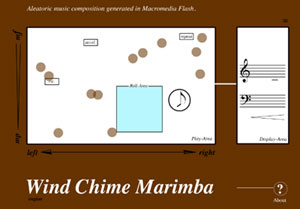
An aleatoric music composition for the internet. Notes are triggered when any Note-Object collides with the ‘Trigger-Object’. Amplitude and pan are derived from the X and Y position of each collision. When the collision occurs within the ‘Roll-Area’, a roll sound is activated. ‘Repeat-Object’ is toggled upon contact with the Trigger-Object and creates the effect of an echo. ‘Accel.’ and ‘Rit.’, alter the velocity of the Trigger-Object upon contact and can dramatically affect the
density of the music.
FPP: Flash Player Piano. (SWF size - 272k)
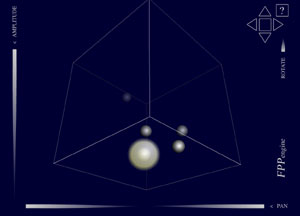
An infinite aleatoric music composition for the internet. Each of the inner sides of the cube represent the different pitches from a six note piano chord. Piano samples (or occasional bass samples) are triggered by the moving spheres which are contained within the 3D space. A leading sample is played and the chord alternates if a sphere collides with another sphere. Amplitude and pan are derived from the X and Y position of each collision. The arrow buttons in the top right corner rotate the cube, whilst playing the composition in real time.
VDS: Virtual Drum Skin. (SWF size - 32k)
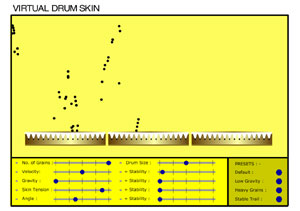
A succession of ‘grains’ are dropped upon virtual drum skins of differing tunings to form rhythmic patterns. Parameters such as gravity/attraction, skin tension, number of grains etc. can be user defined. The user can interact with the program exploring the effect upon the musical output.
CLARA: Internet Instrument (SWF size - 52k)
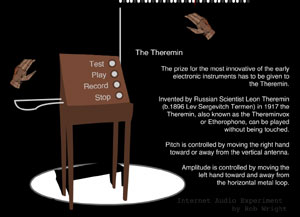
A playable internet instrument based upon the Theremin. Use the mouse to test the instrument - control the on-screen hands, (left hand controls volume, right hand controls pitch). The hand movement can be recorded and replayed. The instrument has a 3 octave range.
PATTERN CHAIN: Internet Instrument (SWF size - 136k)

A playable instrument which generates musical patterns based upon the physical movements of a chain of objects which together simulate the properties of either spring or elastic . The user can initiate a pattern by dragging and releasing an on screen ‘beater’ which is free to perpetually oscillate over the keys of a virtual xylophone. The instrument has a 3 octave range and the resulting patterns can be notated in real time.
Try my Flash based SoundToys here.
Future Directions
“The Internet is at once a world-wide broadcasting capability, a mechanism for information dissemination, and medium for collaboration and interaction between individuals and their computers without regard for geographical location”
[Quote - www.isoc.org/internet/ history (2001)]
The next step that I hope to take is to introduce a two-way communication flow into subsequent projects, either to-and-from a server or more interestingly from user to user. I feel that there is great potential in this area....... An example of this might be an Internet multi-user environment that would allow many people to simultaneously collaborate on, discuss, listen to and interact with a new work as it is being generated...
Sound Emitters in SDK's for 3D Game Engines:

Here, I began to investigate available SDK's for Game Engines, (for example TGE [Torque Game Engine]). With respect to audio in Torque, it appeared to be split into three sections of interest to this research -
[1] GUI Editor - Key elements within the start-up Graphical User Interface can be sonified, [ie. sounds can be attached to buttons and main and sub screens can trigger different audio files]. Also, it would appear that the main game screen can have a superimposed HUD [heads-up display] containing more buttons etc. which can in turn might trigger in-game events (inc. sound).
[2] Scripting - In addition to accessing the source code (C++), Torque includes it own higher level script language (JAVA like) and this can include audio even triggering and control.
[3] World Editor - The bulk of the built in tools are here (including tools for terrain creation and 3d object importing/positioning etc.) and allow for the creation of special objects called 'Audio-Emitters' which can be positioned within a 3d environment and linked to audio-files.
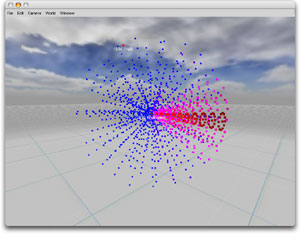
The latter being is quite similar in many respects to research already carried out [in 2d] was therefore the logical place for me start...
However then I discovered the Second Life environment, a much more sociable and exciting place to continue this research.
Next Blog covers 'whisperBox (a 21st century folk song)'.
In the previous blog I discussed the concept behind a new virtual-world audio installation I wanted to create titled 'whisperBox (a 21st century folk song)'.
It occurs to me that it makes sense to introduce this installation by firstly covering some of my earlier research (prior to work in Second Life) that led me this point.
whisperBox is built for use within Second Life, however I really see this installation as the next logical step from my internet-audio experiments that began back in 2001 when I first started tinkering with 'SoundToys', the audio capabilities of Macromedia's Flash and with SDK's for online 3D game environments. This latest installation now complete, I'll use this blog to briefly show some images of the earlier research and then use the next blog to show images of the latest project 'whisperBox' in action within Second Life.
By way of an introduction to this work, here are some short excepts from an article I wrote back in 2001. The article was first published on the front cover of New Notes, a monthly journal by the SPNM (Society for the Promotion of New Music). Five years on, I find it interesting that now a lot of these earlier observations have now become realities:
(If you are interested only in the latest project, skip to next blog).
Internet Audio Experiments. (Extracts)
Thomas Edison was developing a device that could record, then replay at high speed, telegraph signals when he made the first recording of the human voice (Phonograph, 1877). Elisha Gray, who came a close second to Alexander Graham Bell for the title of inventor of the telephone, instead is known as the inventor of the first of the early electronic musical instruments (Musical Telegraph, 1875). Thaddeus Cahill built the precursor to the synthesizer (Telharmonium, 1906), a remarkable machine capable of not only generating but also broadcasting music to public and private residences using telephone technology.
Despite these close beginnings surrounding the technologies of music and those of telecommunication, the World Wide Web remains largely a quiet ‘place’, often more akin to a public library than an integrated multimedia experience. This is not to say that the Internet is mute, far from it, but the relatively slow speed of data transfer typically encountered has precluded the use of audio files from many websites which would otherwise greatly benefit from musical support.
This said, as technology continues to progress, and there is certainly a desire within the Music Industry to utilize the Internet as a means of music delivery (along with other forms of entertainment), we should expect changes and technological advances to cope with the current obstacles. We have already seen some impressive steps forward, for example the introduction of MP3 (a low-loss audio compression which greatly reduces the size of an audio file whilst maintaining high fidelity). In 1997 MP3.com was founded and offered approximately 3000 compressed songs available for free download. In 1998 it became the leading music site on the Internet and received over three million visitors per month, this of course did not pass unnoticed by the commercial eyes of the Music Industry.
More recently we have witnessed the merging of already giant companies from each end of the Music / Internet Service spectrum... ...We have seen the introduction of new legislation concerning the copyright of digital media and ‘Webcasting’ of music. We are also beginning to see a wide-scale take up of ‘Broadband Internet’ by home users. ‘Broadband’ promises much improved transmission speeds and almost certainly brings us one step closer to interactive television and music broadcasting via the Internet.
In the year 2000, the CA*net3 fiber optic network in Canada became the fastest computer network in the world capable of transmitting all nine symphonies of Beethoven in 0.065 seconds.
I find the idea of sharing new musical works, installations, experiments and instruments which have been specially devised for fast Internet delivery very interesting, yet one that has not really been widely taken up. Interesting, in that here is a medium without commercial obstacles, one that easily allows material which may appeal only to a local minority, to find a larger global audience.
I suppose that it is partly because of this freedom, because of the inherent challenge of creating new works for a new medium which are efficient yet interesting (greater than the sum of the parts), and partly because if the ‘Web’ is to become a more interesting ‘place’, music technologists and composers should perhaps begin to claim a much larger stake. For all of these reasons and for personal development, I have decided to begin tentative research into the current possibilities, and limitations of transmitting a variety of music related applications across computer networks.
The following projects are more or less in chronological order:
First up (and isn't it always the way, still one of my personal favorites) is..
WCM: Wind Chime Marimba. (SWF - size 276k)

An aleatoric music composition for the internet. Notes are triggered when any Note-Object collides with the ‘Trigger-Object’. Amplitude and pan are derived from the X and Y position of each collision. When the collision occurs within the ‘Roll-Area’, a roll sound is activated. ‘Repeat-Object’ is toggled upon contact with the Trigger-Object and creates the effect of an echo. ‘Accel.’ and ‘Rit.’, alter the velocity of the Trigger-Object upon contact and can dramatically affect the
density of the music.
FPP: Flash Player Piano. (SWF size - 272k)

An infinite aleatoric music composition for the internet. Each of the inner sides of the cube represent the different pitches from a six note piano chord. Piano samples (or occasional bass samples) are triggered by the moving spheres which are contained within the 3D space. A leading sample is played and the chord alternates if a sphere collides with another sphere. Amplitude and pan are derived from the X and Y position of each collision. The arrow buttons in the top right corner rotate the cube, whilst playing the composition in real time.
VDS: Virtual Drum Skin. (SWF size - 32k)

A succession of ‘grains’ are dropped upon virtual drum skins of differing tunings to form rhythmic patterns. Parameters such as gravity/attraction, skin tension, number of grains etc. can be user defined. The user can interact with the program exploring the effect upon the musical output.
CLARA: Internet Instrument (SWF size - 52k)

A playable internet instrument based upon the Theremin. Use the mouse to test the instrument - control the on-screen hands, (left hand controls volume, right hand controls pitch). The hand movement can be recorded and replayed. The instrument has a 3 octave range.
PATTERN CHAIN: Internet Instrument (SWF size - 136k)

A playable instrument which generates musical patterns based upon the physical movements of a chain of objects which together simulate the properties of either spring or elastic . The user can initiate a pattern by dragging and releasing an on screen ‘beater’ which is free to perpetually oscillate over the keys of a virtual xylophone. The instrument has a 3 octave range and the resulting patterns can be notated in real time.
Try my Flash based SoundToys here.
Future Directions
“The Internet is at once a world-wide broadcasting capability, a mechanism for information dissemination, and medium for collaboration and interaction between individuals and their computers without regard for geographical location”
[Quote - www.isoc.org/internet/ history (2001)]
The next step that I hope to take is to introduce a two-way communication flow into subsequent projects, either to-and-from a server or more interestingly from user to user. I feel that there is great potential in this area....... An example of this might be an Internet multi-user environment that would allow many people to simultaneously collaborate on, discuss, listen to and interact with a new work as it is being generated...
Sound Emitters in SDK's for 3D Game Engines:

Here, I began to investigate available SDK's for Game Engines, (for example TGE [Torque Game Engine]). With respect to audio in Torque, it appeared to be split into three sections of interest to this research -
[1] GUI Editor - Key elements within the start-up Graphical User Interface can be sonified, [ie. sounds can be attached to buttons and main and sub screens can trigger different audio files]. Also, it would appear that the main game screen can have a superimposed HUD [heads-up display] containing more buttons etc. which can in turn might trigger in-game events (inc. sound).
[2] Scripting - In addition to accessing the source code (C++), Torque includes it own higher level script language (JAVA like) and this can include audio even triggering and control.
[3] World Editor - The bulk of the built in tools are here (including tools for terrain creation and 3d object importing/positioning etc.) and allow for the creation of special objects called 'Audio-Emitters' which can be positioned within a 3d environment and linked to audio-files.

The latter being is quite similar in many respects to research already carried out [in 2d] was therefore the logical place for me start...
However then I discovered the Second Life environment, a much more sociable and exciting place to continue this research.
Next Blog covers 'whisperBox (a 21st century folk song)'.
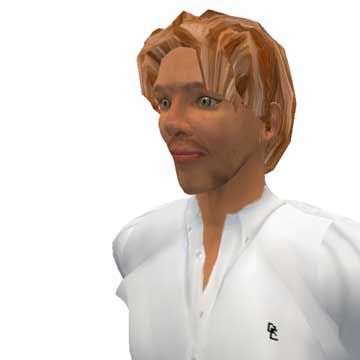
0 Comments:
Post a Comment
<< Home